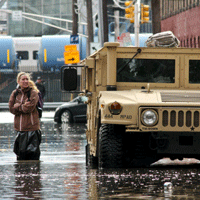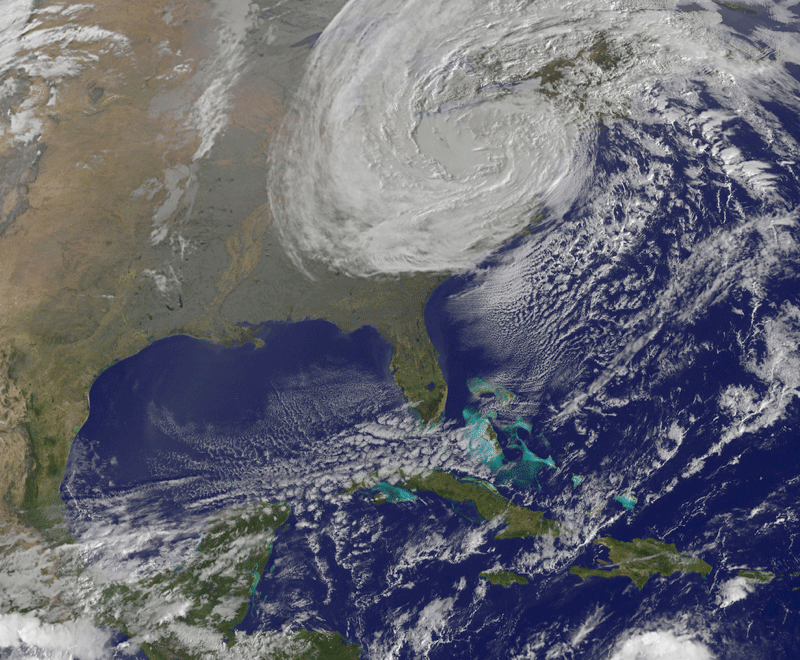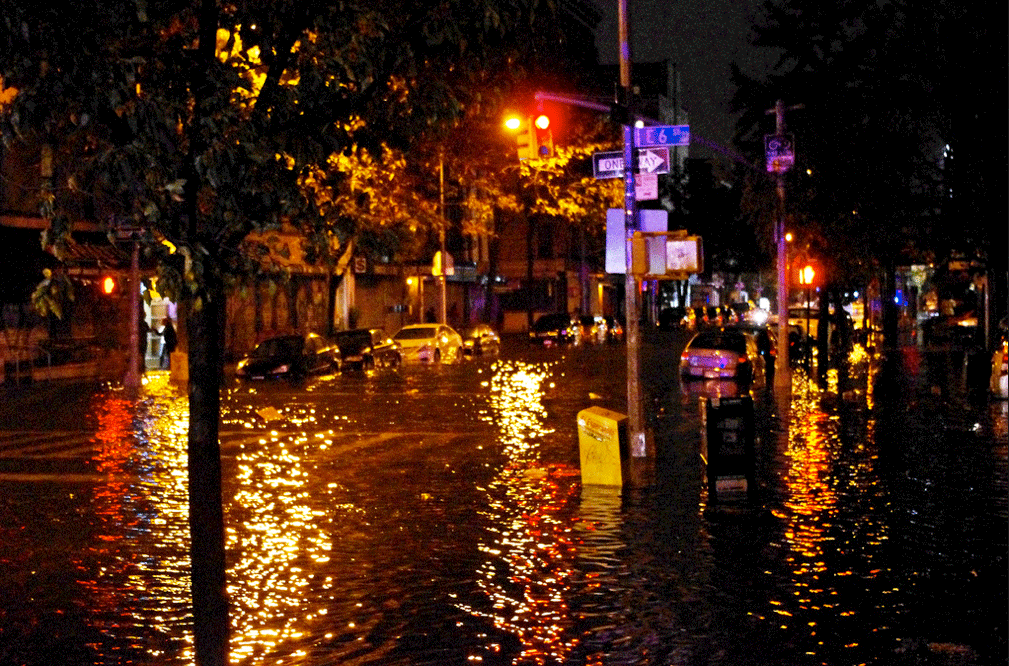Superstorms and Climate Change
Air Date: Week of November 2, 2012
 |
Sandy hit the Eastern U.S. with a powerful punch. The superstorm lashed the coast, flooded whole towns, left millions without power, and dropped snow on towns from Ohio to Tennessee. Host Steve Curwood discusses how climate change contributed to the storm's power with Kevin Trenberth, senior scientist at the National Center for Atmospheric Research.
Transcript
CURWOOD: From the Jennifer and Ted Stanley Studios in Boston, this is Living on Earth, I'm Steve Curwood. Gradually, in the wake of the hurricane that grew into a monster super-storm, people are shoveling out, cleaning up and counting the cost.

A satellite view of super storm Sandy (NASA Goddard)
In all more than a hundred died. Thousands lost their homes. Some businesses are wrecked and may never recover. Millions suffered without power - and many still do. A storm so deadly, powerful and huge seems like an unprecedented event -- but then we've seen Katrina - and Andrew - and Irene - and Ike.
Dr. Kevin E. Trenberth is a climate analyst and senior scientist at the National Center for Atmospheric Research in Boulder and joins us now - welcome to the show!
TRENBERTH: Yes, g'day Steve!
CURWOOD: In the scheme of things, how unusual was hurricane Sandy?
TRENBERTH: Well, hurricane Sandy became very unusual because it was no longer a hurricane when it made landfall, but a hybrid storm, where it had merged with another storm that actually dropped snow here in Colorado late last week, and it became this astro-tropical hybrid storm that had mixed characteristics and more than double the size of a normal hurricane.

Sandy flooded this section of East 6th Street. (David Shankbone)
There were hurricane force winds over a very large area, much more extensive than it would have been had it just been a hurricane.
CURWOOD: Does the experience of Sandy mean that science needs to redefine what a hurricane is?
TRENBERTH: Well, these hybrid storms certainly occur. The elements were sort of aligned here to make this a major storm and I think most of them were very much related to weather. There probably is a small human influence on this that is important, but most of what went on, perhaps there’s more of a crap-shoot aspect to it.
CURWOOD: Talk to me about this near barometric low pressure that was part of Sandy. What does it mean and why was it so low?
TRENBERTH: Well that certainly relates to the size of the storm. It’s just a huge storm, and it does relate to the hybrid character of the storm. The low pressure means that there’s less weight on the ocean, so the ocean wells up a bit more there - there’s the astronomical factors relating to the full moon and also sea level being a little higher than it used to be because of climate change. And so all of these factors came together to produce record breaking storm surges, especially in the southern part of Manhattan.
CURWOOD: So, at the end of the day, in your analysis, how much did climate change have to do with hurricane Sandy?
TRENBERTH: Well firstly on the sea-level side, you know, sea level is going up at just over an inch every decade, a little over a foot per century is the current rate. And so it’s only a few inches, perhaps you can think of it that way, but it also means that sea level is higher than it has ever been. So that’s one factor that adds to some of the coastal damage in particular.
The other factors are that the ocean is warmer. It’s warmer by about one degree Fahrenheit, relative to before the 1970s. That provides more fuel for the storm, it means the air above the storm is a little warmer and also moister, and so this invigorates the storm, so the number I usually quote is about a five to ten percent increase in precipitation. And so this relates even to storms like hurricane Irene last year, or even Isaac, this year where there was extensive flooding in many areas in association with these tropical storms.
CURWOOD: You’ve been studying these for a long time, but science is always full of surprises. What were your surprises that you encountered with the super-storm Sandy?
TRENBERTH: Well, you know, this was certainly being predicted to be a very strong super-storm, but even so the damage was pretty appalling for me to see. And the fact that a number of the subways in southern Manhattan actually did fill with water is very dismaying. In many respects, I’m not surprised, but then when you do see what’s actually happening, it’s always a bit shocking.
CURWOOD: So, hurricane Sandy, or super-storm Sandy, or hybrid Sandy, or whatever you want to call it… this is the new normal and in our warming world, what we can expect for our future hurricane seasons?
TRENBERTH: That’s right, it is a new normal. The way that I think about it overall is that the environment in which these storms are operating has changed. That’s the new normal, and the odds are that these storms are more intense and maybe a little bigger, with the possibility of heavier rains and flooding, that risk exists.
But at the same time, these storms churn up the ocean, they take energy out of the ocean - that’s the evaporation of moisture, that’s evaporative cooling of the ocean, and as a result these storms leave a cold wake behind them. And that’s one of the reasons why hurricanes don’t track along the same path – they’re always choosing a new path across the ocean.
And so one of the effects is that the environment behind a storm is less favorable for a storm, and so we do expect that although there are bigger, more intense storms, there may be fewer storms as a whole. So, one really big storm can take the place of what might have been, say, four or five smaller storms in the past.
CURWOOD: Now, since the world as a whole isn’t making major efforts, really, to address the human part of global climate change, how then should people prepare for a climate that is shifting?
TRENBERTH: Well, firstly, yes; we ought to be working to slow down these effects, and so that relates to the burning of fossil fuels in particular, the increases in carbon dioxide in the atmosphere and we really ought to be trying to reduce those emissions. So the second part of this then is to recognize this is happening and to plan for it.
Planning for these kinds of things is something that we’re also not doing adequately at the current time. And, of course, if you don’t plan, the result is that you suffer the consequences, and that’s been the main strategy that we’ve had so far – we just take it as it comes and then suffer the consequences.
CURWOOD: Kevin Trenberth is a senior scientist at the National Center for Atmospheric Research in Boulder, thank you so much, sir.
TRENBERTH: You're most welcome.
Links
Past interview with Kevin Trenberth on LOE – “Hurricanes and Global Warming.”
Mark Fischetti – “Did Climate Change Cause Hurricane Sandy?” Scientific American Blog
Living on Earth wants to hear from you!
Living on Earth
62 Calef Highway, Suite 212
Lee, NH 03861
Telephone: 617-287-4121
E-mail: comments@loe.org
Newsletter [Click here]
Donate to Living on Earth!
Living on Earth is an independent media program and relies entirely on contributions from listeners and institutions supporting public service. Please donate now to preserve an independent environmental voice.
NewsletterLiving on Earth offers a weekly delivery of the show's rundown to your mailbox. Sign up for our newsletter today!
 Sailors For The Sea: Be the change you want to sea.
Sailors For The Sea: Be the change you want to sea.
 The Grantham Foundation for the Protection of the Environment: Committed to protecting and improving the health of the global environment.
The Grantham Foundation for the Protection of the Environment: Committed to protecting and improving the health of the global environment.
 Contribute to Living on Earth and receive, as our gift to you, an archival print of one of Mark Seth Lender's extraordinary wildlife photographs. Follow the link to see Mark's current collection of photographs.
Contribute to Living on Earth and receive, as our gift to you, an archival print of one of Mark Seth Lender's extraordinary wildlife photographs. Follow the link to see Mark's current collection of photographs.
 Buy a signed copy of Mark Seth Lender's book Smeagull the Seagull & support Living on Earth
Buy a signed copy of Mark Seth Lender's book Smeagull the Seagull & support Living on Earth

